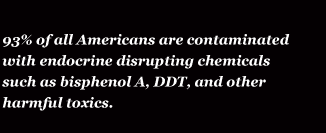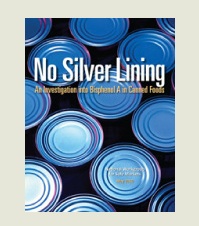



www.nosilverlining.org
Avoiding BPA in Holiday Food
By National Work Group for Safe Markets
Most people would like to enjoy a nontoxic, safe Holiday feast with family this season.
Finding foods packaged in non-toxic materials (or with no packaging at all) isn’t
impossible for most of us, it just takes a little prep work before you go shopping.
Since food can linings cans are a major source of BPA exposure, think about preparing a
menu that does not require canned foods.
Eden Foods is the only food manufacturer that has had a longstanding commitment to
BPA-free can linings – their canned beans have been packed in BPA-free cans. The
exceptions are their tomato products, which do have BPA in the cans.
If you use prepared tomato products, try and use products in glass jars, or secondarily,
“tetra paks” – made of cardboard/metal/polyethylene.
Fresh is always best, so, for example, plan to make fresh cranberry sauce with your
partner, kids, or friends, here’s a simple recipe for tart cranberry sauce:
http://www.living-foods.com/recipes/cranberrysauce.html
Can linings aren’t the only place you’ll find BPA while cooking and shopping this
season. BPA is also in polycarbonate plastic food containers and in thermal paper
receipts. Ask if the store has paper receipts, and decline a thermal paper receipt. If you do
have to handle thermal paper receipts from ATMs or other sources, be sure to wash your
hands as soon as possible after handling. Don’t allow children to handle thermal paper
receipts. BPA absorbs more when hands are wet or greasy.
When in doubt, ask your store manager if products you are interested in buying have
BPA in them or if not BPA, what else. This action will raise awareness with your local
retailers and encourage them to look for suppliers with BPA-free products.
Purchase drinks in glass bottles, and use glass, ceramic, or stainless steel at home for
holding food or drink. Increasingly glass storage containers are available for liquid foods
and cotton reusable baggies for dry goods. Also Mason jars of various sizes can be used
for leftover soup, gravy, sauces and the like. Available at most hardware stores, they are a
convenient throwback storage idea your Grandparents may have used.
The makers of Saran Wrap say that they removed the BPA from their product years ago,
so you can use that for wrapping leftovers or use wax paper with rubber bands.
BPA Linked Health Effects
The U.S. National Toxicology Program states: "The NTP has some concern for effects on
the brain, behavior, and prostate gland in fetuses, infants, and children at current human
exposures to bisphenol A."i
The Food & Drug Administration says: “Both the National Toxicology Program at the
National Institutes of Health and FDA have some concern about the potential effects of
BPA on the brain, behavior, and prostate gland in fetuses, infants, and young children. "ii
BPA at low dose exposure is linked to health effects.iii
BPA can make cancer more aggressive in breast cancer patients.iv
BPA has estrogen-like properties and in pregnant animals has been linked to female
infertility, according to the Endocrine Societyv
Bisphenol A exposure in pregnant mice permanently changes DNA of offspring.vi
BPA is linked to sperm damage, vii and erectile dysfunction.viii
BPA can be absorbed through the skin.ix
BPA in Products
The Work Group for Safe Markets’ report, No Silver Lining, An Investigation into
Bisphenol A in Canned Foods,x tested canned foods for BPA and detected it in 92%, of
the canned food samples.
• The highest level of BPA—1,140 part per billion (ppb), to our knowledge the
highest level ever found in the U.S.—was detected in DelMonte French Style
Green Beans from a participant’s pantry in Wisconsin.
• Other high scorers included Wal-Mart’s Great Value Green Peas from a store in
Kentucky, and Healthy Choice Old Fashioned Chicken Noodle Soup from a
pantry in Montana.
• On average, the products contained 77.36 ppb of bisphenol A.
• BPA levels varied even among the same products purchased in different regions.
Similar testing of canned foods by Consumer’s Union,xi University of Texas,xii and
Health Canadaxiii confirm that BPA migrates from food can linings into the food
contained by the cans.
• Consumers Union also found the highest levels of BPA in DelMonte Green
Beans.xiv
A recent survey of food companies by investment firm Green Century and shareholder
group As You Sow xv reported that major companies such as Con Agra and Heinz are
working urgently to remove BPA from their cans. If your favorite product is in a BPA
containing can, contact the company and ask how they are coming along with removing
BPA from their cans.
Regulation
After France and Denmark restricted BPA, Germany warned consumers to avoid it, and
Scotland began efforts to restrict it, the European Union voted to ban BPA from baby
bottles on Thursday November 25th.xvi
The United Arab Emirates announced it will ban BPA in baby bottles.xvii
In the US, legislatures in 20 states have considered banning BPA in children's products.
As of October 2010, seven states had voted to ban BPA in baby bottles: Connecticut,
Minnesota, Washington, Wisconsin, Vermont, Maryland and New York. Chicago and
four counties in New York — Albany, Rockland, Schenectady and Suffolk — also have
banned BPA in baby bottles. A Massachusetts health advisory warned pregnant and
nursing women last year to choose fresh or frozen products, rather than food in cans,
which often contain BPA in their plastic linings.xviii1
For more info: www.nosilverlining.org
End Notes
i
National Institutes of Health, Questions and Answers about Bisphenol A, accessed November 23, 2010
http://www.niehs.nih.gov/news/media/questions/sya-bpa.cfm
ii
Food & Drug Administration, Update on Bisphenol A (BPA for Use in Food: January 2010,
http://www.fda.gov/newsevents/publichealthfocus/ucm064437.htm
iii
The Endocrine Society, Studies Raise Concern about Low-Dose BPA Effects; FDA Draft Assessment
Fails to Consider Same Studies September 5, 2008, http://www.endo-
society.org/advocacy/insider/ConcernaboutLow-DoseBPAEffects2.cfm
iv
Cancer Research, April 1, 2008, Bisphenol A induces a profile of tumor aggressiveness in high-risk cells
from breast cancer patients http://www.ncbi.nlm.nih.gov/pubmed/18381411
v
The Endocrine Insider, The Society's Scientific Statement on Endocrine-Disrupting Chemicals Continues
to Garner National News Coverage , October 21, 1010
vi
The Endocrine Society, Bisphenol A exposure in pregnant mice permanently changes DNA of offspring,
June 12, 2009, http://www.endo-society.org/media/ENDO-
09/Research/BisphenolAexposureinpregnantmice.cfm
vii
Reproductive Toxicology, July 23, 2010, Semen quality and sperm DNA damage in relation to urinary
bisphenol A among men from an infertility clinic.
http://www.ncbi.nlm.nih.gov/pubmed/20656017
viii
Journal of Human Reproduction, Occupation exposure to bisphenol-A (BPA and the risk of Self-
Reported Mae Sexual Dysfunction, April 9, 2009,
http://humrep.oxfordjournals.org/content/25/2/519.abstract
ix
Journal of Analytical and Bioanalytical Chemistry, Transfer of bisphenol A from thermal paper to the
skin, March 21, 2010, http://www.scribd.com/doc/43420941/Transfer-of-bisphenol-A-from-thermal-
printer-paper-to-the-skin
x
National Work Group for Safe Markets, No Silver Lining, An Investigation into Bisphenol A in Canned
Foods, May 18, 2010 http://ej4all.org/contaminatedwithoutconsent/nosilverlining.php
xi
Consumer’s Union, Concern over canned foods, December 2009,
http://www.consumerreports.org/cro/magazine-archive/december-2009/food/bpa/overview/bisphenol-a-
ov.htm
xii
Journal of Environmental Science & Technology, Bisphenol A (BPA) in U.S. Food November 1, 2010,
http://pubs.acs.org/doi/abs/10.1021/es102785d?prevSearch=%2528bisphenol%2BA%2529%2BNOT%2B
%255Batype%253A%2Bad%255D%2BNOT%2B%255Batype%253A%2Bacs-
toc%255D&searchHistoryKey=
xiii
Health Canada, Survey of Bisphenol A in Canned Food Products from Canadian Markets, June 2010,
http://www.hc-sc.gc.ca/fn-an/pubs/securit/bpa_survey-enquete-can-con-eng.php
xiv
Consumer’s Union, Concern over canned foods, December 2010
http://www.consumerreports.org/cro/magazine-archive/december-2009/food/bpa/what-we-
found/bisphenol-a-what-we-found.htm
xv
Green Century Investments and As You Sow, Seeking Safer Packaging, October 21, 2010,
http://asyousow.org/health_safety/2010BPAreportSum2.shtml
xvi
EU bans bisphenol A chemical from Babies’ bottles, BBC, November 25, 2010
http://www.bbc.co.uk/news/world-europe-11843820
xvii
UAE to ban BPA baby bottles, Emirates News, http://www.emirates247.com/news/emirates/uae-to-ban-
bpa-baby-bottles-2010-11-28-1.322183
xviii
Massachusetts Department of Public Health,Pubic Health Advisory Regarding Bisphenol A, August 3rd,
2009
http://www.mass.gov/?pageID=eohhs2pressrelease&L=1&L0=Home&sid=Eeohhs2&b=pressrelease&f=09
0803_bpa_advisory&csid=Eeohhs2